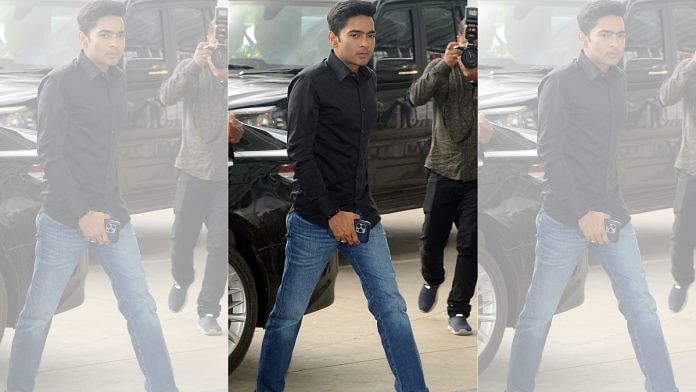New Delhi: The Supreme Court Friday ordered the Enforcement Directorate (ED) to withdraw the Look Out Circular (LOC) issued against Trinamool Congress MP Abhishek Banerjee and his wife Rujira in a case related to money laundering in an alleged coal smuggling scam in West Bengal.
The division bench of justices S.K. Kaul and Sudhanshu Dhulia passed the direction in an application filed by the Banerjees seeking to travel abroad for medical reasons.
The ED told the bench that the necessary orders would be issued to facilitate their travel abroad if they inform the agency a week in advance.
During Friday’s hearing, Additional Solicitor General (ASG) S.V. Raju, appearing for the ED, said that as far as Abhishek Banerjee was concerned, the ED has relaxed the LOC and allowed him to travel from 26 July to 20 August. He said Rujira has also been allowed to travel abroad several times in the past.
On 5 June, Rujira was allegedly stopped from boarding a UAE-bound flight citing a lookout notice issued by the ED that asked her to appear before the agency.
Appearing for the petitioners, senior advocate Kapil Sibal asked if there was no LOC in place. The ASG said that there was a pending LOC owing to certain apprehensions.
“The problem is this…When somebody goes (abroad), you say we have not done it (issued LOC) and we have given the permission,” Justice Kaul observed, adding, “The pendency of the LOC creates a scenario that somebody, somewhere is stopped. It is not done.”
“There is an LOC. You recall the LoC, that is all. They will seek permission whenever they have to go. They will intimate you in advance,” the bench told Raju.
When Raju argued that there were serious allegations against the couple in the alleged coal smuggling scam, the bench observed that in a criminal matter, it is the prosecution’s burden to prove its case beyond all reasonable doubt.
The use of LOCs to prevent citizens from travelling abroad remains a contested issue, and several high courts have taken objection to it over the years. Earlier this year, the Delhi HC called it a “coercive measure” which should be used “sparingly” only in exceptional cases and not in a routine manner as it may affect the liberty of an accused.
ThePrint explains what an LOC is, the procedure around it, and who has the power to issue it.
Also read: ‘Prima facie there is no evidence’ — SC order granting bail to two accused in Bhima Koregaon case
What is an LOC and when is it issued?
Delhi-based lawyer Shashank Sharma, who practises in matters relating to economic offences and criminal law, says LOCs are governed by the guidelines and office memoranda issued by the Ministry of Home Affairs (MHA).
Currently, there is no law with provisions to issue an LOC and hence, it does not have any statutory power. Police officers have the power to make arrests and proclaim someone as an absconder under the Criminal Procedure Code (CrPC).
An LOC is issued to restrict an individual accused in a cognisable offence by the law enforcement authorities from leaving the country where the alleged crime has been committed. It is used to prevent and monitor the entry and exit of individuals who may be required by law enforcement authorities. The LOC is usually sent to immigration checkpoints at international airports and seaports.
In some cases, the police can approach the court to restrain someone from leaving the country on the basis of an apprehension that the person may not join the investigation once they have left. The person against whom an LOC has been issued can, however, challenge it in court.
The provision was first issued by the MHA in 1979 through an office memorandum, and two subsequent memos were issued in 2000 and 2010.
Who can issue an LOC
In its 1979 memorandum, the MHA stated that LOCs are issued to check the arrival or departure of foreigners and Indians “whose arrival/departure has been banned by the concerned authorities”.
The ministry also provided basic guidelines for issuing such notices, and clarified that the authorities that could issue LOCs included the Ministry of External Affairs (MEA), the customs and income tax departments, the Directorate of Revenue Intelligence, the Central Bureau of Investigation (CBI), Interpol, regional passport officers and police authorities in various states.
A 2000 MHA memorandum specified the steps for issuing an LOC in respect of an Indian citizen. This required that the request be made to all the immigration check posts in India and include the accused person’s complete particulars.
Another memorandum in 2010 specified the ranks of officers in the central and state government agencies and the police who could issue anLOC.
Both the 1979 and 2010 memoranda say that the request for opening an LOC against an individual can be made to the Bureau of Immigration, which must be approved by an officer not below the rank of deputy secretary to the Government of India, or joint secretary to a state government, or a superintendent of police at the district level.
The investigating officer is required to make a written request for an LOC to an officer of the relevant rank, providing the details as well as the reason for seeking such a circular against an accused.
In 2018, the MHA made amendments to the 2010 memorandum, empowering officers of the Serious Fraud Investigation Office as well the chairpersons/managing directors/chief executive officers of Public Sector Banks to request an LOC.
According to the amendment, immigration authorities can detain as well as prevent anyone against whom an LOC has been issued, including wilful defaulters, from leaving India.
These provisions were also explained in detail in the Lok Sabha in 2020 by Minister of State for Home Affairs Nityanand Rai.
(Edited by Smriti Sinha)



